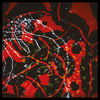Brian Eno
Biography
Ambient pioneer, glam rocker, hit producer, multimedia artist, technological innovator, worldbeat proponent, and self-described non-musician — over the course of his long, prolific, and immensely influential career, Brian Eno was all of these things and much, much more. Determining his creative pathways with the aid of a deck of instructional, tarot-like cards called Oblique Strategies, Eno championed theory over practice, serendipity over forethought, and texture over craft; in the process, he forever altered the ways in which music is approached, composed, performed, and perceived, and everything from punk to techno to new age bears his unmistakable influence.. Brian Peter George St. John le Baptiste de la Salle Eno was born in Woodbridge, England, on May 15, 1948. Raised in rural Suffolk, an area neighboring a U.S. Air Force base, as a child he grew enamored of the "Martian music" of doo wop and early rock & roll broadcast on American Armed Forces radio; a subsequent tenure at art school introduced him to the work of contemporary composers John Tilbury and Cornelius Cardew, as well as minimalists John Cage, LaMonte Young, and Terry Riley. Instructed in the principles of conceptual painting and sound sculpture, Eno began experimenting with tape recorders, which he dubbed his first musical instrument, finding great inspiration in Steve Reich's tape orchestration "It's Gonna Rain."
Top Albums |

1. Nerve Net (E..
 | 
2. The Shutov A..
 | ![Neroli (Thinking Music, Pt. IV) [Expanded Edition], Brian Eno](https://s.mzstatic.com/htmlResources/F4E5/frameworks/images/p.png)
3. Neroli (Thin..
 | 
4. Everything T..
 | 
5. Ambient 1: M..
 |

6. My Life In t..
 | 
7. Apollo: Atmo..
 | 
8. Small Craft ..
 | 
9. LUX
 | 
10. The Pearl
 |

11. Outside
 | 
12. Another Gree..
 | 
13. Here Come th..
 | 
14. Drums Betwee..
 | 
15. Ambient 2: T..
 |

16. Thursday Aft..
 | 
17. Discreet Mus..
 | 
18. Ambient 4: O..
 | 
19. Taking Tiger..
 | 
20. Before and A..
 |
|
Top Songs |
| Name | Album | Time | Price | |
| 1. | Ending (Ascent) | Apollo: Atmospheres & S.. | 4:26 | $1.29 |  |
| 2. | Needles In the Camel's Eye (2004.. | Here Come the Warm Jets | 3:11 | $1.29 |  |
| 3. | Strange Overtones | Everything That Happens Wil.. | 4:16 | $0.99 |  |
| 4. | Roil, The Choke | Nerve Net (Expanded Edition.. | 5:02 | $1.29 |  |
| 5. | Riverside | Shutov Assembly (Expanded E.. | 3:51 | $1.29 |  |
| 6. | Spinner | Greater Lengths | 2:57 | $1.29 |  |
| 7. | River | Greater Lengths | 4:24 | $1.29 |  |
| 8. | From the Beginning (From "Opera&.. | Argento vivo, Vol. 2 - EP | 3:54 | $0.99 |  |
| 9. | Dune 'Desert Theme' (From &#.. | Instrumental Favourites, Pt.. | 5:07 | $0.99 |  |
| 10. | Failing Light | Ambient 2: The Plateaux of .. | 4:14 | $1.29 |  |
| 11. | Wind In Lonely Fences | Ambient 2: The Plateaux of .. | 3:58 | $1.29 |  |
| 12. | Among Fields of Crystal | Ambient 2: The Plateaux of .. | 3:24 | $1.29 |  |
| 13. | Chill Air | Ambient 2: The Plateaux of .. | 2:13 | $1.29 |  |
| 14. | Not Yet Remembered | Ambient 2: The Plateaux of .. | 3:50 | $1.29 |  |
| 15. | Arc of Doves | Ambient 2: The Plateaux of .. | 6:29 | $1.29 |  |
| 16. | Above Chiangmai | Ambient 2: The Plateaux of .. | 2:55 | $1.29 |  |
| 17. | Plateaux of Mirror | Ambient 2: The Plateaux of .. | 4:13 | $1.29 |  |
| 18. | Steal Away | Ambient 2: The Plateaux of .. | 1:29 | $1.29 |  |
| 19. | First Light | Ambient 2: The Plateaux of .. | 7:06 | $1.29 |  |
| 20. | Brutal Ardour | Discreet Music | 8:13 | $1.29 |  |
| 21. | French Catalogues | Discreet Music | 5:19 | $1.29 |  |
| 22. | Fullness of Wind | Discreet Music | 9:55 | $1.29 |  |
| 23. | Taking Tiger Mountain | Taking Tiger Mountain By St.. | 5:32 | $1.29 |  |
| 24. | China My China | Taking Tiger Mountain By St.. | 4:44 | $1.29 |  |
| 25. | True Wheel | Taking Tiger Mountain By St.. | 5:11 | $1.29 |  |
Top Music Videos |

1. Life In Techn...
 | 
2. Violet Hill
 | 
3. Lost!
 | 
4. Christmas Lig...
 | 
5. Life In Techn...
 |

6. Christmas Lig...
 | 
7. Life In Techn...
 |

